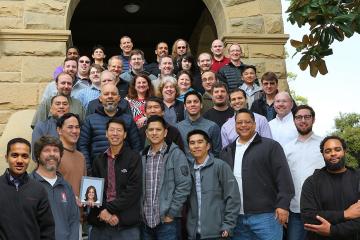CRC Deploys Computers 33 Percent Faster

Have you ever wanted to achieve the same results faster? University IT’s Computer Resource Consulting (CRC) group developed a way to do just that.
CRC came up with a new solution to deploy computers 33 percent faster, helping faculty and staff clients get operational sooner. Now, the group is exploring ways to offer this system to others across campus.

University IT’s Computer Resource Consulting group
Introducing Deployment in the Next Generation (DiNG), a new system that deploys new and replacement computers for Stanford faculty and staff. The system installs additional software to the out-of-the-box computer only as needed, rather than loading all computers with software its user may not need.
In use since last spring, DiNG has already resulted in 1,500 hours saved, hours that CRC can now dedicate to other priorities. And that’s just for computers CRC configured for its current clients since last February.
“Initially, our goal was to identify ways to deploy computers more efficiently for our current clients,” said Brad Immanuel, University IT’s director of CRC. “We’ve seen such success, we are now exploring ways to offer this as a service to other groups across campus.”
If the solution is scaled and implemented for new clients in other schools and units across campus, the efficiency improvement would result in even more time and money savings for the university.
The change
It once took CRC consultants about three hours to deploy each new or replacement computer. With DiNG, it takes an hour less. How?
Until launching DiNG, CRC used the same traditional system to do these deployments since 2007. Often called “thick imaging,” one computer was set up, carbon copied, and then the copy was applied to all new computers. This system had worked wonderfully for years, but with CRC’s increasing volume, CRC set out to find a new approach to computer deployment that would save both time and money, and also improve client service.
After identifying core concepts such as simplicity, agility, flexibility, ease of use, and the need for efficiency, a project team began working on a new system. Under the new system, CRC uses much of what computers come with from the vendor, and layer on additional items as needed one-by-one with Stanford-specific customization. For example, the new DiNG system leverages Stanford encryption tools, campus licensing for Microsoft Windows, and much more.
“DiNG is the result of the CRC team’s commitment to working smarter and delivering better service to clients,” said Nate Wagenaar, CRC’s manager responsible for DiNG. “The project has been a massive success.”
The progress
Through grit and hard work by many of CRC’s consultants, DiNG has improved already since its initial rollout last spring. A second version of the system will be released soon. It includes an improved interface and allows DiNG to be easily used in additional scenarios, such as when computers fail and need to be reinstalled.
With growing interest in DiNG from schools and units across the university, it’s likely the early success of DiNG is just the beginning.
Learn more
CRC provides fee-based IT support to Stanford schools and units to help areas save time, money, and effort in having to manage their own IT staff.
If you’d like to learn more about DiNG or how CRC can assist your area using DiNG, email Nate Wagenaar.
DISCLAIMER: UIT News is accurate on the publication date. We do not update information in past news items. We do make every effort to keep our service information pages up-to-date. Please search our service pages at uit.stanford.edu/search.



